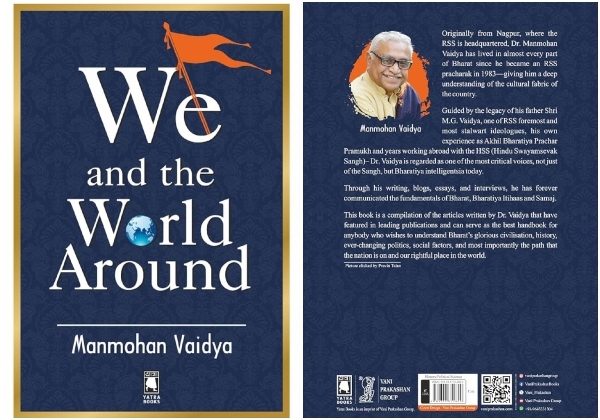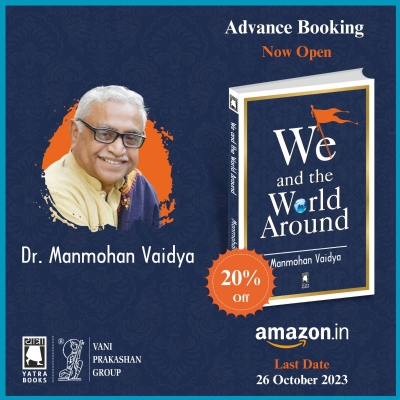BOOK REVIEW | Understanding RSS and its ideology: “We and the World Around”, book by Dr. Manmohan Vaidya
26 Oct 2023 10:59:04
To purchase the We and the World Around book, click here and here
Dr. Manmohan Vaidya’s book – “We and the World Around” will be released at the most appropriate time. It has come when the world is experiencing conflict between terrorists, led by Hamas and Israel. Hamas- Israel conflict broke out when the war between Russia and Ukraine was still in progress. Capitalism, communism, and religion are mainly involved in two conflicts, proving their inbuilt inadequacy and shallowness as ideologies.
Dr. Vaidya’s book comes as a big hope against this backdrop as it emphasizes the significance and importance of `Bhartiya Vichar Darshan’, which teaches the mantra of “Vasudhaiv Kutumbkam” and upholds values of democracy, tolerance, acceptance, adoption, and liberty for centuries. Bhartiya Darshan is preaching and practicing all these values when the rest of the world is living with primitive ideas.

Dr. Manmohan Vaidya is the joint-general secretary of Rashtriya Swayamsewak Sangh (RSS). He has been associated with RSS since his childhood - for decades - and has carried out various responsibilities in the organization. His enriched experience as an activist and thinker is reflected in the book, which is published by Vani Prakashan, New Delhi.
“We and the World Around” is important on two counts. Firstly, it presents Bhartiya's ideology in a much-needed perspective. Secondly, it gives insight into the ideology and functioning of RSS, which will be celebrating its centenary in 2025. RSS work is growing every day. Its acceptance is rising not only in the country but at the international level. Many people have curiosity and want to know more about RSS at a global level. This book will be helpful to satisfy all their questions.
The author’s deep conviction of his ideology is manifested in every word. He has not hesitated to say that he had deliberately used terms like Bharat and Bhartiya instead of India or Indian. The author, in the preface, explained how the United States is facing a challenge of national identity. He observes that the sentiment of WE and THEY prevail in the US in the absence of national identity and the dominance of multiculturalism. Dr. Vaidya extends his logic by saying that the identity of Bharat is determined by Western institutions and ideology when the responsibility to determine identity – `SELF’ - lies with ourselves. Bharat's identity is determined by external forces. Dr. Vaidya underlines that Bharat, like other Western countries, is not merely a political community, having a social contract, but a spiritually based geo-cultural identity. For Dr. Vaidya, Bharat stands for continuous search for truth as it has an attitude of welcoming, accepting, and enriching its own thoughts.
The preface is self-explanatory, which gives an ideological canvas and provides perception to the readers. The book briefs about the ideological foundation of RSS, its 98-year-old journey, and its style of functioning. However, Dr. Vaidya also pooh-poohed communist and leftist thoughts, which are transplanted or outsourced in Bharat. Despite several hardships and difficulties, RSS continues to grow because of its ideological strength and organizational base. Dr. Vaidya explains RSS’s dynamic journey saying that the organization has passed through three phases and is passing through the fourth phase currently. In the fourth phase, RSS expects its volunteers to mold themselves and be instrumental in social awakening and change.

Critics describe RSS as an undemocratic organization. Dr. Vaidya shares his first-person account and maintains how democracy is followed in the RSS. He, in fact, recalls how senior RSS leaders always encouraged him to express his views freely.
Dr. Vaidya takes a dig at communists saying that RSS does not need ‘glasnost’ as Bhartiya Darshan always respects all the views, unlike Semitic society, where only one version is entertained. In Semitic society, a decision is taken by a handful of people while others submit themselves. As against this, consensus is the most outstanding feature of Bhartiya ideology. The author reminds the reader how Bruno was burnt alive in Rome and Galileo was tortured due to the views, that were not acceptable to Christianity.
RSS is not a rigid organization, as seen by its critics. In fact, openness and constant change have been the most outstanding features of RSS. Dr. Vaidya shares an interesting incident to prove his point. He recalls how necessary changes were made in the prayer of Hindu Swayamsewak Sangh (HSS) when some errors were pointed out. This is significant as prayer is considered as the utmost sacred by RSS volunteers.
Two articles on the visit of former President Pranab Mukherjee to the Nagpur training camp are interesting as it exposes the double standards of communists/leftists and Congress. Mukherjee was under pressure from his own party to avoid Nagpur's visit while he was targeted by leftists. But Pranab Da did not succumb to any pressure and went ahead with his decision. Dr. Vaidya, rightly, attributes this to the pure democratic mindset of RSS and Mr Mukherjee as both of them have deep faith in the Bhartiya concept of democracy, which always respects others’ views. Two chapters are interesting to read as the author was witness to all the developments.
Dr. Vaidya has elaborately discussed certain fundamental concepts like Sanatan, the difference between national and nationalistic, and why Bharat has always been ‘nityanutan’. Dr. Vaidya says that ‘Sanatan’ is an adjective to Rashtra. Sanatan has no beginning and end as it is purely based on spirituality. He rightly points out that Bharat survived despite several invasions for centuries as it never depended upon state or political power. Bharat has its own spiritually based arrangement because of which it survived all the aggressions. To substantiate his point, Dr. Vaidya says that a number of ‘smrities’ were written from time to time and the constitution was the latest ‘smriti’.
The author seeks to differentiate between national and nationalistic saying that the term nationalistic was a by-product of Western idea of the nation-state. He argues that nationalistic countries have their roots in the capitalist ideological past, which imposed world wars on humanity. As against this, Bhartiya's ideas subscribe to a holistic integrated approach despite having different identities. The adoption of this idea is a manifestation of the nation.
The book has another interesting chapter on the renovation of the Somnath temple. Congress was divided on the issue as Jawarlal Nehru opposed the move saying that it would be Hindu revivalism. But another group of Sardar Patel, Dr. Rajendra Prasad, the then president of India, and K M Munshi went ahead despite opposition from Nehru. Readers would be shocked to know how Nehru, who is always described as the `icon of democracy’, censored the speech of Dr. Rajendra Prasad. But for Munshi, the renovation of Somnath temple was the restoration of collective subconsciousness.
Dr Vaidya has extensively written on Article 370 and 35 (A). RSS was dead against Article 370 from the beginning. It passed a categorical resolution in 1953. He emphasized that Article 370 was a temporary provision, which was made in view of the situation prevailing at that time. He points out that Article 35 (A) came into existence because of a Presidential Order and never got Parliament approval. He goes on to say how Article 370 was discriminatory against women and SC/ ST communities. It even made people second-class citizens; he argues. The author does not hesitate to blame Jawaharlal Nehru and Shaikh Abdullah for depriving the people of Kashmir of all the development for seven decades.
The article titled `Dead on the left’ is interesting to read. It exposes the hypocrisy of leftists/communists. Being the senior leader of RSS, Dr. Vaidya experienced several incidents, showing the limitations of communism and the gap between `talk and walk’ of communist leaders. He states that West Bengal and Kerala are examples of intolerant and undemocratic attitudes of communists. He shares two separate incidents at Jaipur Literature Festivals when organizers were not keen on inviting RSS leaders. Communist leader Sitaram Yechuri even announced to boycott of the event. He shares another incident, involving Vivek Agnihotri was manhandled at the venue for expressing ‘non-communist thoughts.’ Poet Prasun Joshi, who wrote patriotic songs, was also opposed by the organizers. Article shows how communists/leftists project themselves as torchbearers of democracy, freedom of expression and equality but are always afraid of different views.
Dr. Vaidya also explains the concept of Akhand Bharat, which according to him, is a geo-cultural idea. Akhand Bharat is not a geo-political expansionism but aims at restoration of Bhartiya ideas. Explaining his point, Dr. Vaidya points out that Bharat, unlike Western countries, never enslaved the local population, even though it had worldwide trade relations. Bhartiya's ideas spread without sending a single soldier or envoy, which is self-explanatory.
The book has two separate articles on RSS founder Dr. Hedgewar and veteran pracharak Dattopant Thengdi. It gives readers information on Dr Hedgewar’s association with the freedom movement and the efforts he had taken to lay a strong foundation to RSS. Gratitude for Dattopant Thengdi is also seen in a separate article. Dattopant was not merely known for his organizational skills but also as a thinker. The book recognizes efforts taken by Dattopant to expand patriotic thoughts in communist-dominated fields of trade unions and student movement.
The book needs to be welcomed as it is the most appropriate time when people of this country are awakening from their suppressed and denied identity. RSS has been a serious victim of intellectual misleading and misinformation campaigns, led by communists and leftists. While popular support for communists is rapidly shrinking, it continues to dominate intellectual and academic circles. Aware of this reality, communists have become more hyper and may go to any extent, to ignore national interests.
Dr. Vaidya has not merely shown hypocrisy and ideological limitations of communism or western ideologies but also has focused on the strength and potential of Bhartiya Vichar Darshan to lead the world, which is looking for peace due to the failure of all the models.
